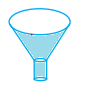

capacity of the frustum shaped bucket=28.490 l=28490 cm3
r1= radius of the top of the frustum= 28cm
r2= radius of the bottom of the frustum= 21cm
we know that volume of a frustum= $\frac {\pi h(r_1^2 + r_2^2+ r_1r_2)}{3}$
$28490=\frac {22\times h \times (282+212+28 \times 21)}{7 \times 3} $
h=15 cm
Hence Answer (b)
Here Total Volume of Sphere = Cylinderical volume of water rised
Radius of cylinder(R)= 9 cm
Height of cylinder(H) = 40 cm
Radius of Sphere(r) = 3 cm
So,Number of Lead sphere(n) = Volume of Cylinder/Volume of sphere
=$\frac{\pi r^2h}{\frac{4}{3} \pi r^3}$
Substituting the values
n=90
hence the Answer (a)
Volume of the cylindrical portion of the tank= $\pi r^2h$
=22/7 * (10.5)2 * 18
= 6237cm3
Volume of 2 conical ends
=$2(\frac {1}{3} \pi r^2h) =2/3 * 22/7 * (21/2)2 * 9
=2079cm3
Therefore, capacity of the tank= 6237 + 2079= 8316cm3
Hence the Answer (a)
The volume of cone is given by formula
V =$ \frac {1}{3}\pi R^{2}h$
Volume of the hemisphere =$ \frac {2}{3}\pi R^{3}$
Volume of the cylinder =$ \pi R^{2}h$
Now Height(H)= Radius (R) as they have height
Volume of Cone=$ \frac {1}{3}\pi R^{3}$
Volume of the hemisphere =$ \frac {2}{3}\pi R^{3}$
Volume of the cylinder =$ \pi R^{3}$
Ratio will be 1:2:3
Hence the Answer (c)
Volume of first cone = $ \frac {1}{3}\pi r_1^{2}h$
Volume of second cone = $ \frac {1}{3}\pi r_2^{2}h$
According to the question, the 2 cones are melted and recast to form a sphere of radius R.
Therefore, volume of first cone + volume of second cone = volume of sphere.
$ \frac {1}{3}\pi r_1^{2}h + \frac {1}{3}\pi r_2^{2}h= \frac {4}{3}\pi R^{3}$
$(r_1^{2} + r_2^{2})h=4R^{3}$
$h=\frac {4R^3}{r_1^{2} + r_2^{2}}$

Let the radius of the sphere = r
Surface area of the sphere = $4\pi r^2$
Radius of the cylinder circumscribed over the sphere = r
Height of the cylinder circumscribed over the sphere (h) = 2r
Curved surface area of the cylinder = $2\pi rh$
= $2\pi r(2r)
= $4\pi r^2$
Therefore, the curved surface area of the circumscribed cylinder over a sphere is equal to the surface area of the sphere.
Let h be the height, l the slant height and r1 and r2 the radii of the circular bases of a frustum of a cone.
We have, h = 8 cm, r1= 9 cm and r2 = 3 cm
(i) Let H be the height of the cone of which the bucket is part. Then
$H=\frac {hr_1}{r_1 - r_2}$
Substituting the given values
H=12cm
(ii) Volume of the water which can be filled in the bucket
= Volume of the frustum
=$\frac {\pi}{3}(r_1^2+r_2^2+r_1r_2)h$
=312cm3
(iii) Area of the copper sheet required to make the bucket, where l is the slant height of the frustum is given by
=$\pi (r_1+r_2)l+\pi r_2^2
Where $l=\sqrt {(r_1-r_2)^2 + h^2} = 10cm$
So Area of copper sheet
=$129\pi$ cm2
Hence the Answers
(i) 12cm
(ii) 312 cm3
(iii) $129\pi$ cm2
The volume of one person = 0.04 m3
Now The amount of water displaced is equal to the volume of the person.
500 people take dip at the same time, then water displaced = 500 * 0.04 = 20 m3
Let h be the height of water raised,then Volume of the water rises will be
=Base X Height = $80 \times 50 h$ = 4000h m2
Now Volume of Water rises = Volume of water displaced by 500 people
4000h=20
h=1/200 m =0.005 m= 5 millimeters
Given
$2\pi r_1 = 18$
$\pi r_1 = 9 $
$2\pi r_2 = 6$
$\pi r_2 = 3$
l = 4 cm
curved surface area = $(\pi r_1 + \pi r_2 )l$
=(9+3)4=48 cm2


a. False b.True c. True
This Class 10 Maths Worksheet for Surface Area and Volume with answers is prepared keeping in mind the latest syllabus of CBSE . This has been designed in a way to improve the academic performance of the students. If you find mistakes , please do provide the feedback on the mail.
Go back to Class 10 Main Page using below links